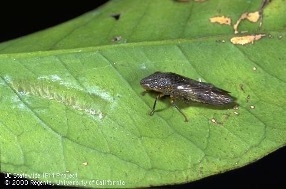The glassy-winged sharpshooter is a large leafhopper that can transmit several important, often fatal, plant diseases in California. This includes Pierce's disease of grape, alfalfa dwarf, almond leaf scorch, and mulberry leaf scorch. Pierce's disease is of most concern in California since the state accounts for about 94% of U.S. grape production.
Pierce's disease of grape has been reported in many counties throughout California. View a map of the current distribution of the pathogen. Glassy-winged sharpshooter adults are ½ inch long and dark brown to black with light-colored spots on their heads. Eggs are laid in masses under the leaf surface, resembling a greenish blister. Once the eggs hatch, the egg mass turns brown and remains as a scar on the leaf.
What can you do?
Glassy-winged sharpshooter feeds on many woody plants as well as annual and perennial herbaceous plants. It is common to find this invasive insect on acacia, avocado, eucalyptus, citrus, crepe myrtle, heavenly bamboo, grape, photinia, pittosporum, hibiscus, periwinkle, xylosma, some roses, and many others. Inspect plants for this pest, especially new shoots or growth. Use yellow-sticky card traps to monitor their populations.
If you find glassy-winged sharpshooter in an area not currently known to have this pest, immediately call the California Department of Food & Agriculture Pest Hotline at 1-800-491-1899, or contact your local agricultural commissioner's office.
To learn more about this pest and the diseases is transmits, visit Pest Notes: Glassy-winged Sharpshooter.
